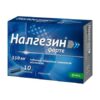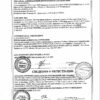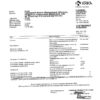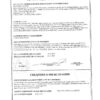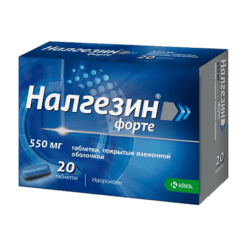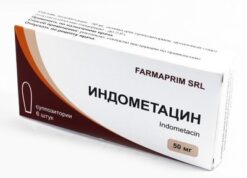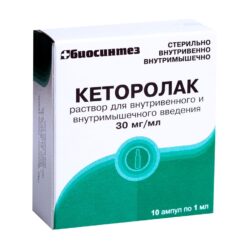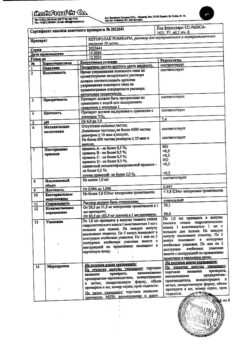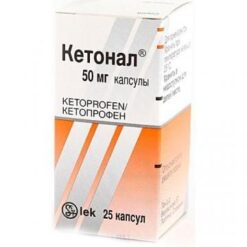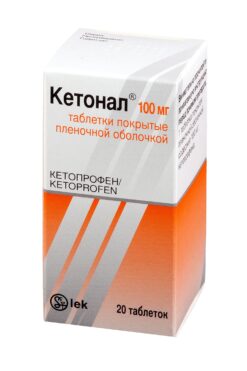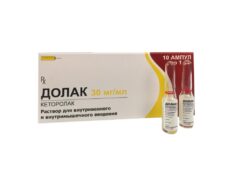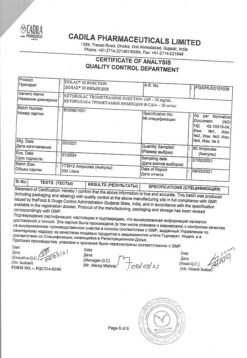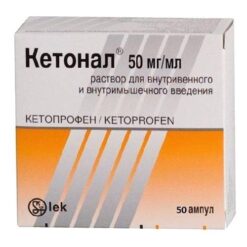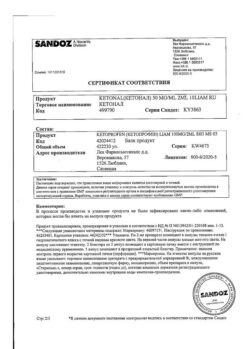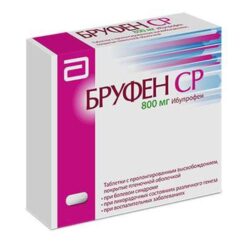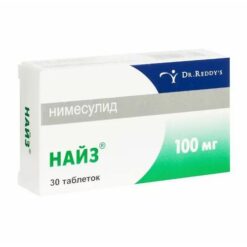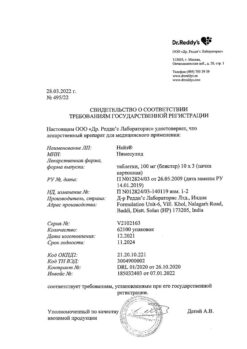No products in the cart.
Nalgesin forte, 550 mg 10 pcs
€1.00
Out of stock
(E-mail when Stock is available)
Description
Pharmacotherapeutic group: nonsteroidal anti-inflammatory drug
ATX code: M01AE02
Pharmacological properties
Pharmacodynamics
The drug Nalgesin® forte is naproxen and has analgesic, antipyretic and anti-inflammatory effects. The mechanism of action is associated with non-selective inhibition of cyclooxygenase-1 and -2 (COX-1, COX-2) activity.
The drug Nalgesin ® forte, film-coated tablets are well soluble, quickly absorbed from the gastrointestinal tract and provides rapid onset of analgesic effect.
Pharmacokinetics
It is quickly and completely absorbed from the gastrointestinal tract. Bioavailability is 95% (eating has practically no effect on the completeness or speed of absorption). Time to reach maximum concentration is 1-2 hours. Blood plasma protein binding is 99 %. The elimination half-life is 12-15 hours. Metabolism occurs in the liver to dimethylnaproxen with participation of CYP2C9 isoenzyme. Clearance is 0.13 ml/min/kg. Excreted by the kidneys is 98%, 10% is excreted unchanged, 0.5-2.5% is excreted in the bile. The equilibrium concentration in blood plasma is determined after 4-5 doses of the drug (2-3 days).
In case of renal insufficiency cumulation of metabolites is possible.
Indications
Indications
Diseases of the musculoskeletal system (rheumatoid arthritis, psoriatic, juvenile chronic arthritis, ankylosing spondylitis (ankylosing spondylitis), gouty arthritis, rheumatic soft tissue lesions, osteoarthritis of peripheral joints and spine, including with radicular syndrome, tenosynovitis, bursitis).
Pain syndrome of mild or moderate severity: neuralgia, ossalgia, myalgia, lumboischialgia, post-traumatic pain syndrome (sprains and bruises), accompanied by inflammation, pain in the postoperative period (in traumatology, orthopedics, gynecology, maxillofacial surgery), headache, migraine, algodismenorrhea, adnexitis, toothache.
As part of complex therapy for infectious and inflammatory diseases of the ear, nose and throat with severe pain (pharyngitis, tonsillitis, otitis media).
Feverish syndrome with “colds” and infectious diseases.
The drug Nalgesin® forte is used for symptomatic therapy (to reduce pain, inflammation and lower body temperature) and does not affect the progression of the underlying disease.
Pharmacological effect
Pharmacological effect
Pharmacotherapeutic group: non-steroidal anti-inflammatory drug
ATX code: M01AE02
Pharmacological properties
Pharmacodynamics
The drug Nalgesin® forte is naproxen, has analgesic, antipyretic and anti-inflammatory effects. The mechanism of action is associated with non-selective inhibition of the activity of cyclooxygenase-1 and -2 (COX-1, COX-2).
The drug Nalgesin® forte, film-coated tablets, dissolves well, is quickly absorbed from the gastrointestinal tract and provides a rapid onset of analgesic effect.
Pharmacokinetics
Quickly and completely absorbed from the gastrointestinal tract. Bioavailability – 95% (food intake has virtually no effect on either the completeness or the rate of absorption). Time to reach maximum concentration is 1-2 hours. Plasma protein binding > 99%. The half-life is 12-15 hours. Metabolism occurs in the liver to dimethylnaproxen with the participation of the CYP2C9 isoenzyme. Clearance – 0.13 ml/min/kg. 98% is excreted by the kidneys, 10% is excreted unchanged, with bile – 0.5-2.5%. The equilibrium concentration in the blood plasma is determined after taking 4-5 doses of the drug (2-3 days).
In case of renal failure, accumulation of metabolites is possible.
Special instructions
Special instructions
Do not exceed the doses specified in the instructions. To reduce the risk of developing adverse events from the gastrointestinal tract, the minimum effective dose should be used for the shortest possible short course.
If pain and fever persist or get worse, you should see a doctor.
Patients with bronchial asthma, bleeding disorders, as well as patients with hypersensitivity to other analgesics should consult a doctor before taking Nalgesin® forte.
Caution should be used in patients with liver disease and renal failure. In patients with renal failure, creatinine clearance should be monitored. When CC is below 30 ml/min, the use of naproxen is not recommended. In chronic alcoholism and other forms of liver cirrhosis, the concentration of unbound naproxen increases, so lower doses are recommended for such patients. After two weeks of using the drug, monitoring of liver function indicators is necessary.
The drug Nalgesin® forte should not be taken together with other anti-inflammatory and painkillers, except as prescribed by a doctor.
Lower doses are also recommended for elderly patients.
Naproxen should be avoided within 48 hours before surgery. If it is necessary to determine 17-corticosteroids, the drug should be discontinued 48 hours before the study. Similarly, naproxen may affect the determination of 5-hydroxyindoleacetic acid in urine.
The use of naproxen, like other drugs that block prostaglandin synthesis, may affect fertility and is therefore not recommended for women planning pregnancy.
Each tablet of Nalgesin® forte contains approximately 50 mg of sodium. When limiting salt intake, this must be taken into account.
Impact on the ability to drive vehicles and machinery
Naproxen slows down the reaction rate in patients. This should be taken into account when driving and performing tasks that require increased attention.
Active ingredient
Active ingredient
Naproxen
Composition
Composition
1 film-coated tablet contains:
Core
Active ingredient:
Naproxen sodium 550.00 mg
Excipients: povidone K30, microcrystalline cellulose, talc, magnesium stearate, purified water
Film shell: Opadry 02F2050041
1Opadray 02F205004: hypromellose, titanium dioxide (E171), macrogol, indigo carmine dye (E132).
Pregnancy
Pregnancy
The drug Nalgesin® forte is not recommended for use during pregnancy and breastfeeding.
Contraindications
Contraindications
· Hypersensitivity to naproxen or naproxen sodium.
· Complete or incomplete combination of bronchial asthma, recurrent polyposis of the nose or paranasal sinuses and intolerance to acetylsalicylic acid and other nonsteroidal anti-inflammatory drugs (NSAIDs) (including a history).
· The period after coronary artery bypass surgery.
· Erosive and ulcerative changes in the mucous membrane of the stomach or duodenum, active gastrointestinal bleeding.
· Inflammatory bowel diseases (ulcerative colitis, Crohn’s disease) in the acute phase.
· Hemophilia and other bleeding disorders.
· Cerebrovascular bleeding or other bleeding.
· Decompensated heart failure.
· Severe liver failure or active liver disease.
· Severe renal failure (creatinine clearance (CC) less than 30 ml/min), progressive kidney disease, confirmed hyperkalemia.
· Pregnancy, breastfeeding period.
· Children under 16 years of age.
With caution
Coronary heart disease, cerebrovascular disease, congestive heart failure, dyslipidemia/hyperlipidemia, diabetes mellitus, peripheral arterial disease, smoking, impaired renal function (creatinine clearance 30-60 ml/min), history of ulcerative lesions of the gastrointestinal tract (GIT), presence of Helicobacter pylori infection, use in elderly patients, systemic lupus erythematosus or mixed connective tissue diseases (Sharp’s syndrome), long-term use of NSAIDs, frequent alcohol consumption, severe somatic diseases, concomitant therapy with the following drugs: anticoagulants (for example, warfarin), antiplatelet agents (for example, acetylsalicylic acid, clopidogrel), oral glucocorticoids (for example, prednisolone), selective serotonin reuptake inhibitors (for example, citalopram, fluoxetine, paroxetine, sertraline).
Side Effects
Side Effects
Adverse effects that may occur during treatment with naproxen are classified according to the following frequencies: very common (³ 1/10), common (³ 1/100 to < 1/10), uncommon (³ 1/1,000 to <1/100), rare (³ 1/10,000 to < 1/1,000), very rare (< 1/10,000), frequency unknown (cannot be determined from available data).
Gastrointestinal disorders: the most frequently observed adverse events were gastrointestinal. Peptic ulcers, perforation or gastrointestinal bleeding may develop, sometimes fatal, especially in elderly patients (see section “Special Instructions”).
Within each group, adverse events are listed in descending order of severity.
Blood and lymphatic system disorders:
uncommon: eosinophilia, granulocytopenia, leukopenia, thrombocytopenia.
Nervous system disorders:
often: headache, vertigo, dizziness, drowsiness;
uncommon: depression, sleep disturbances, inability to concentrate, insomnia, malaise.
Visual disorders:
often: visual impairment.
Hearing and labyrinth disorders:
often: tinnitus, hearing loss;
uncommon: hearing loss.
Cardiac disorders:
often: swelling, palpitations;
uncommon: congestive heart failure.
Disorders of the respiratory system, chest and mediastinal organs:
often: shortness of breath;
uncommon: eosinophilic pneumonia.
Gastrointestinal disorders:
often: constipation, abdominal pain, dyspepsia, nausea, diarrhea, stomatitis, flatulence;
uncommon: gastrointestinal bleeding and/or gastric perforation, hematemesis, melena, vomiting;
very rarely: relapse or exacerbation of ulcerative colitis or Crohn’s disease;
frequency unknown: gastritis.
Disorders of the liver and biliary tract:
uncommon: increased activity of liver enzymes, jaundice.
Disorders of the skin and subcutaneous tissues:
often: skin itching, skin rash, ecchymosis, purpura;
uncommon: alopecia, photodermatoses;
very rare: bullous reactions, including Stevens-Johnson syndrome and toxic epidermal necrolysis.
Musculoskeletal and connective tissue disorders:
uncommon: myalgia and muscle weakness.
Renal and urinary tract disorders:
uncommon: glomerulonephritis, hematuria, interstitial nephritis, nephrotic syndrome, renal failure, renal papillary necrosis.
General disorders and disorders at the injection site:
often: thirst, increased sweating;
uncommon: hypersensitivity reactions, menstrual irregularities, hyperthermia (chills and fever).
Edema and symptoms of heart failure and increased blood pressure have been reported during NSAID therapy.
Clinical studies and epidemiological data suggest that the use of some NSAIDs (especially high doses and long-term therapy) may be associated with a small increase in the risk of arterial thrombosis (eg, myocardial infarction or stroke).
Undesirable effects for which a cause-and-effect relationship with the use of naproxen has not been established
Blood and lymphatic system disorders: aplastic anemia, hemolytic anemia.
Nervous system disorders: aseptic meningitis, cognitive dysfunction.
Skin and subcutaneous tissue disorders: erythema multiforme, photosensitivity reactions similar to porphyria cutanea tarda and epidermolysis bullosa, urticaria.
Vascular disorders: vasculitis.
General disorders and disorders at the injection site: angioedema, hyperglycemia, hypoglycemia.
If you notice such phenomena, stop taking the drug and, if possible, consult a doctor.
Interaction
Interaction
When treating with anticoagulants, be aware that naproxen may prolong bleeding time. Nalgesin® forte should not be used simultaneously with acetylsalicylic acid or other NSAIDs, including selective cyclooxygenase-2 inhibitors (increased risk of side effects).
According to clinical pharmacodynamics, simultaneous use of naproxen and acetylsalicylic acid for more than one day can inhibit the effect of low dose acetylsalicylic acid on platelet activity, the inhibition may persist for several days after discontinuation of naproxen therapy. The clinical significance of this interaction is unknown.
Patients concomitantly receiving hydantoins, anticoagulants, or other drugs that are significantly bound to plasma proteins should be monitored for signs of potentiation of action or overdose of these drugs.
Nalgesin® forte may reduce the antihypertensive effect of propranolol and other beta-blockers, and may also increase the risk of renal failure associated with the use of angiotensin-converting enzyme (ACE) inhibitors. NSAIDs may reduce the diuretic effect of diuretics. Naproxen inhibits the natriuretic effect of furosemide. Diuretics may increase the risk of NSAID nephrotoxicity.
Inhibition of renal clearance of lithium leads to an increase in plasma lithium concentrations. Taking probenecid increases the plasma concentration of naproxen.
Cyclosporine increases the risk of developing renal failure.
Naproxen slows down the excretion of methotrexate, phenytoin, and sulfonamides, increasing the risk of developing their toxic effects.
Antacids containing magnesium and aluminum reduce the absorption of naproxen.
Myelotoxic drugs increase the manifestations of hematotoxicity of the drug.
According to in vitro studies, the simultaneous use of naproxen and zidovudine increases the concentration of zidovudine in the blood plasma.
Concomitant use of corticosteroids may increase the risk of GI ulceration or bleeding.
NSAIDs may enhance the effect of anticoagulants such as warfarin.
The simultaneous use of naproxen and antiplatelet drugs, selective serotonin reuptake inhibitors increases the risk of gastrointestinal bleeding.
Concomitant use of NSAIDs is not recommended for 8-12 days after using mifepristone.
Concomitant use of NSAIDs and tacrolimus increases the risk of nephrotoxicity.
Overdose
Overdose
Symptoms
A significant overdose of naproxen may be characterized by drowsiness, dyspeptic disorders (heartburn, nausea, vomiting, abdominal pain), weakness, tinnitus, irritability, and in severe cases, hematemesis, melena, impaired consciousness, convulsions and renal failure.
Treatment
A patient who has accidentally or intentionally taken a large amount of Nalgesin® forte must rinse the stomach, take activated charcoal and undergo symptomatic therapy: antacids, H2 receptor blockers, proton pump inhibitors. Hemodialysis is ineffective.
Storage conditions
Storage conditions
At a temperature not exceeding 25 °C, in the original packaging.
Keep out of the reach of children.
Shelf life
Shelf life
5 years.
Do not use the drug after the expiration date.
Manufacturer
Manufacturer
KRKA dd Novo Mesto, Slovenia
Additional information
| Shelf life | 5 years. Do not use the product after the expiration date. |
|---|---|
| Conditions of storage | At temperature not exceeding 25°C, in original packaging. Store out of reach of children. |
| Manufacturer | KRKA dd Novo mesto, Slovenia |
| Medication form | pills |
| Brand | KRKA dd Novo mesto |
Other forms…
Related products
Buy Nalgesin forte, 550 mg 10 pcs with delivery to USA, UK, Europe and over 120 other countries.





